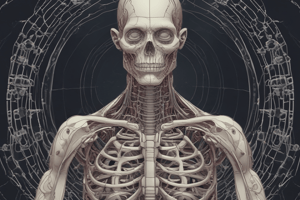Podcast
Questions and Answers
What is the primary function of the skeletal system?
What is the primary function of the skeletal system?
- Facilitates movement
- Transports gases and nutrients
- Regulates metabolism
- Provides structure and protects organs (correct)
Which of the following systems is responsible for gas exchange in the body?
Which of the following systems is responsible for gas exchange in the body?
- Nervous System
- Cardiovascular System
- Digestive System
- Respiratory System (correct)
What is one of the main functions of the muscular system?
What is one of the main functions of the muscular system?
- Produces hormones
- Stores genetic material
- Facilitates movement (correct)
- Removes waste products
Which organ system includes the heart and blood vessels?
Which organ system includes the heart and blood vessels?
What role do ribosomes play in cells?
What role do ribosomes play in cells?
Which system is primarily involved in regulating body functions through hormones?
Which system is primarily involved in regulating body functions through hormones?
How do negative feedback loops contribute to homeostasis?
How do negative feedback loops contribute to homeostasis?
Which type of tissue provides support and binds other tissues?
Which type of tissue provides support and binds other tissues?
What is the main function of the urinary system?
What is the main function of the urinary system?
Which of the following organs is part of the digestive system?
Which of the following organs is part of the digestive system?
Flashcards are hidden until you start studying
Study Notes
Overview of Human Anatomy and Physiology
- Anatomy: The study of the structure and organization of the body.
- Physiology: The study of the functions and processes of the body systems.
Major Body Systems
-
Skeletal System
- Composed of bones, cartilage, and ligaments.
- Functions: Provides structure, protects organs, anchors muscles, stores calcium.
-
Muscular System
- Composed of skeletal, smooth, and cardiac muscles.
- Functions: Facilitates movement, maintains posture, produces heat.
-
Nervous System
- Includes the brain, spinal cord, and nerves.
- Functions: Controls body activities, responds to stimuli, processes information.
-
Endocrine System
- Composed of glands that secrete hormones (e.g., thyroid, adrenal).
- Functions: Regulates growth, metabolism, and homeostasis through hormonal signals.
-
Cardiovascular System
- Composed of the heart and blood vessels.
- Functions: Transports nutrients, gases, hormones, and wastes throughout the body.
-
Respiratory System
- Includes the lungs, trachea, and diaphragm.
- Functions: Facilitates gas exchange (oxygen and carbon dioxide) and helps regulate blood pH.
-
Digestive System
- Composed of organs such as the mouth, stomach, intestines, liver.
- Functions: Breaks down food, absorbs nutrients, eliminates waste.
-
Urinary System
- Includes kidneys, ureters, bladder, and urethra.
- Functions: Removes waste products from the blood, regulates water and electrolyte balance.
-
Reproductive System
- Males: Testes, penis, prostate (produces sperm).
- Females: Ovaries, uterus, vagina (produces eggs).
- Functions: Produces gametes, nurtures developing offspring.
Cellular Structure and Function
-
Cell Types:
- Epithelial: Covers body surfaces, lines cavities.
- Muscle: Facilitates movement.
- Nervous: Transmits signals.
- Connective: Supports, binds, and protects other tissues.
-
Organelles:
- Nucleus: Stores genetic material.
- Mitochondria: Produces energy (ATP).
- Ribosomes: Synthesizes proteins.
Homeostasis
- Definition: The maintenance of a stable internal environment.
- Mechanisms: Involves feedback loops (negative and positive) to regulate bodily functions.
Key Concepts
- Tissue Types: Epithelial, connective, muscle, nervous.
- Organ Systems: Groups of organs that work together to perform complex functions.
- Anatomical Position: Standard position for anatomical terminology, standing erect, facing forward, arms at the sides, palms forward.
Importance of Anatomy and Physiology
- Understanding body structure and function helps in diagnosing diseases, developing treatments, and improving health outcomes.
Overview of Human Anatomy and Physiology
- Anatomy studies body structure and organization; physiology examines body functions and processes.
Major Body Systems
- Skeletal System: Made up of bones, cartilage, and ligaments; provides structure, protects organs, anchors muscles, stores calcium.
- Muscular System: Composed of skeletal, smooth, and cardiac muscles; responsible for movement, posture maintenance, and heat production.
- Nervous System: Includes the brain, spinal cord, and nerves; controls activities, responds to stimuli, and processes information.
- Endocrine System: Consists of hormone-secreting glands such as the thyroid and adrenal; regulates growth, metabolism, and homeostasis through hormones.
- Cardiovascular System: Features the heart and blood vessels; transports nutrients, gases, hormones, and waste throughout the body.
- Respiratory System: Encompasses the lungs, trachea, and diaphragm; facilitates gas exchange and helps regulate blood pH.
- Digestive System: Composed of organs like the mouth, stomach, intestines, and liver; breaks down food, absorbs nutrients, and eliminates waste.
- Urinary System: Includes kidneys, ureters, bladder, and urethra; removes waste from blood and regulates water and electrolyte balance.
- Reproductive System: Male components include testes, penis, and prostate (produces sperm); female components are ovaries, uterus, and vagina (produces eggs); responsible for gamete production and nurturing offspring.
Cellular Structure and Function
- Cell Types:
- Epithelial: Covers surfaces, lines cavities.
- Muscle: Facilitates body movement.
- Nervous: Transmits signals.
- Connective: Supports, binds, and protects tissues.
- Organelles:
- Nucleus: Stores genetic material.
- Mitochondria: Produces ATP for energy.
- Ribosomes: Synthesizes proteins.
Homeostasis
- Homeostasis is the maintenance of a stable internal environment; regulated through feedback loops (negative and positive).
Key Concepts
- Tissue Types: Epithelial, connective, muscle, nervous.
- Organ Systems: Groups of organs working together for complex functions.
- Anatomical Position: Standard anatomical terminology with the body standing erect, facing forward, arms at the sides, and palms forward.
Importance of Anatomy and Physiology
- Understanding anatomy and physiology aids in diagnosing diseases, developing treatments, and enhancing health outcomes.
Studying That Suits You
Use AI to generate personalized quizzes and flashcards to suit your learning preferences.




